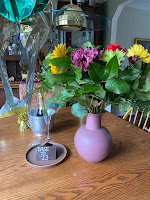Saturday, April 30, 2022
The bees return
Saturday, April 23, 2022
Launch!
Launch this year was April 23. For the first time in two years, it wasn't delayed due to the pandemic.
However, Rob was down for the count with Covid, and for some miraculous reason (or effective booster shots), I was still testing negative.
So, for the first time ever, I was part of the launch crew, assigned to pads. On the previous shift, someone with the same duties had crunched their hand. I was pretty skittish to start with, and this news made me even more nervous.
Pete M helped orient me to my duties and stayed until I had successfully managed 4 boats (so appreciated!). The pad part was easy, applying light pressure to keep them in place until the boat had lifted. It was the sling that was a bit more intimidating - grabbing hold while it was in mid air and then placing it on the bow of the hull so the vessel could be lifted.
The shift was just 4.5 hours but felt like a full day's work. At the end of my shift, I was happy to have been a part of the successful operation. And Yondering was in the water! Mike P took the helm and motored her into the slip.
Saturday, April 16, 2022
Full Egg Moon - April 2022
- The Phoenix was adopted as a Christian symbol in the first century AD. It appears on funeral stones in early Christian art, churches, religious paintings, and stonework. The egg from which it rose has become our Easter egg. As with many symbols, the Easter egg has continued to shift. When the Lenten fast was adopted in the third and fourth centuries, observant Christians abstained from dairy products, including milk, cheese, butter, and eggs. In England, on the Saturday before Lent, it was common practice for children to go from door to door to beg for eggs—a last treat before the fast began.
- Ancient Egyptians believed in a primeval egg from which the sun god hatched. Alternatively, the sun was sometimes discussed as an egg itself, laid daily by the celestial goose, Seb, the god of the earth. The Phoenix is said to have emerged from this egg. The egg is also discussed in terms of a world egg, molded by Khnum from a lump of clay on his potter's wheel.In the Zoroastrian religion, the creation myth tells of an ongoing struggle between the principles of good and evil. During a lengthy truce of several thousand years, Evil hurls himself into an abyss and Good lays an egg, which represents the universe with the earth suspended from the vault of the sky at the midway point between where good and evil reside. Evil pierces the egg and returns to earth, and the two forces continue their battle.In Findland, Luonnotar, the Daughter of Nature floats on the waters of the sea, minding her own business when an eagle arrives, builds a nest on her knee, and lays several eggs. After a few days, the eggs begin to burn and Luonnotar jerks her knee away, causing the eggs to fall and break. The pieces form the world as we know it: the upper halves form the skies, the lower the earth, the yolks become the sun, and the whites become the moon.
- In China, there are several legends that hold a cosmic egg at their center, including the idea that the first being or certain people were born of eggs. For example, the Palangs trace their ancestry to a Naga princess who laid three eggs, and the Chin will not kill the king crow because it laid the original Chin egg from which they emerged.
- Hinduism makes a connection between the content of the egg and the structure of the universe: for example, the shell represents the heavens, the white the air, and the yolk the earth. The Chandogya Upanishads describes the act of creation in terms of the breaking of an egg.
Saturday, April 9, 2022
Amaro and Bar Revel
 |
| Norman Foster |
 |
| Magic City |
Friday, April 8, 2022
Happy 35th Anniversary!

















